Boyle J.A. The Cambridge History of Iran, Volume 5: The Saljuq and Mongol Periods
Подождите немного. Документ загружается.

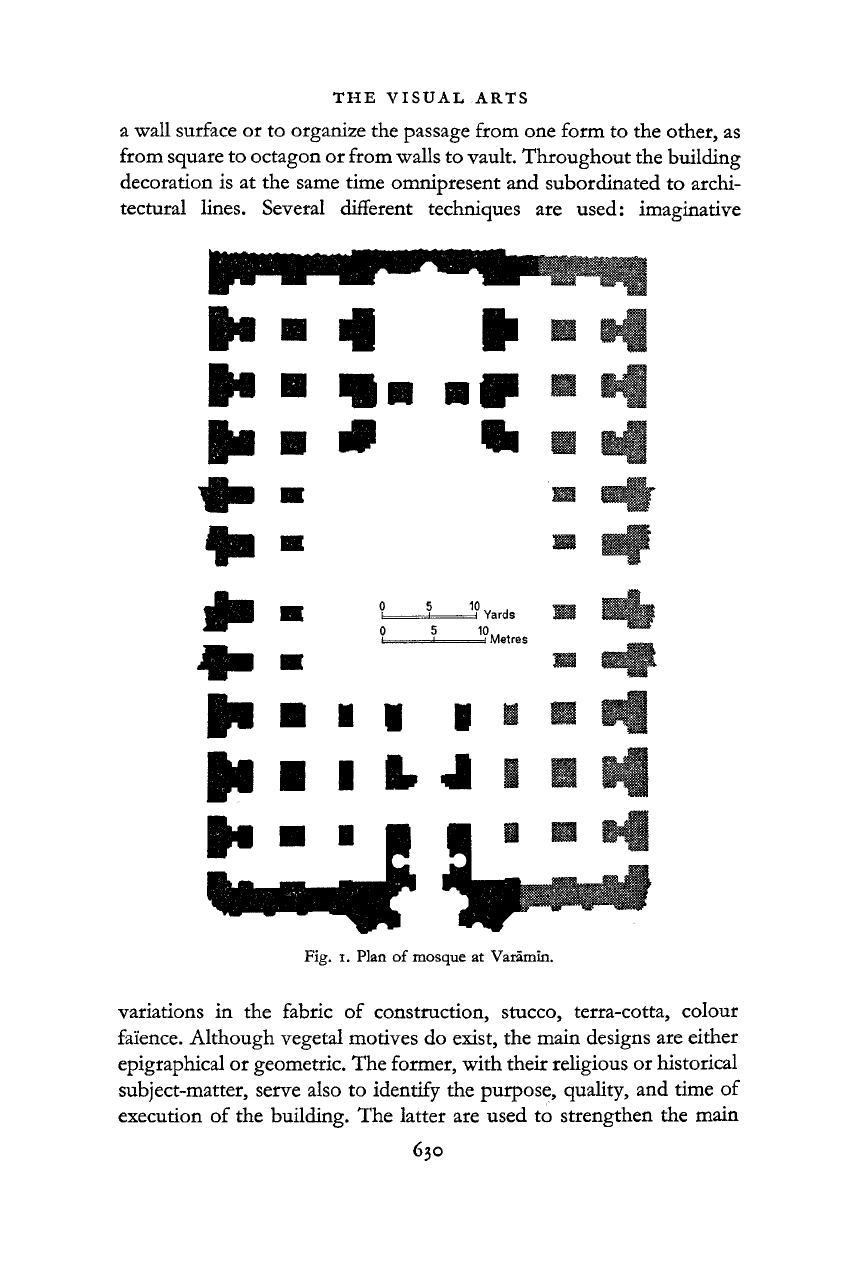
THE VISUAL ARTS
a
wall
surface or to organize the passage from one form to the other, as
from square to octagon or from
walls
to vault. Throughout the building
decoration is at the same time omnipresent and subordinated to archi-
tectural lines. Several different techniques are used: imaginative
»•
»•
•
4
Fig. I.
Plan
of
mosque
at
Varâmin.
variations in the fabric of construction, stucco, terra-cotta, colour
faïence.
Although vegetal motives do exist, the main designs are either
epigraphical or geometric. The former, with their religious or historical
subject-matter, serve also to identify the purpose, quality, and time of
execution
of the building. The
latter
are used to strengthen the main
630
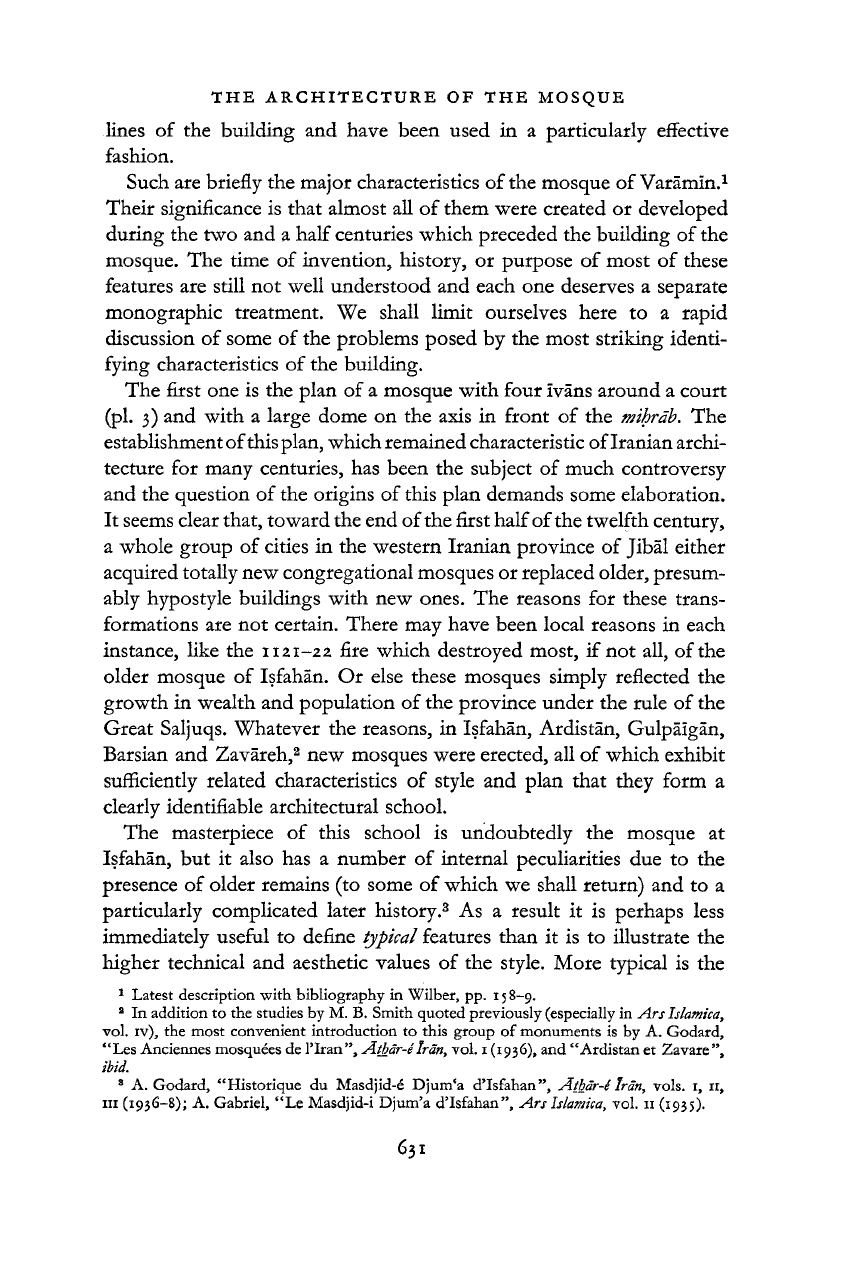
THE ARCHITECTURE OF THE MOSQUE
631
lines
of the building and have been used in a particularly
effective
fashion.
Such
are briefly the major characteristics of the mosque of Varamin.
1
Their
significance is
that
almost all of them were created or developed
during the two and a half centuries which preceded the building of the
mosque. The time of invention, history, or purpose of most of these
features are still not
well
understood and each one deserves a separate
monographic
treatment.
We shall limit ourselves here to a rapid
discussion
of some of the problems posed by the most striking identi-
fying
characteristics of the building.
The
first one is the plan of a mosque with four Ivans around a court
(pi.
3) and with a large dome on the axis in front of the mihrab. The
establishment
of
this plan, which remained characteristic
of
Iranian
archi-
tecture for many centuries, has been the subject of much controversy
and the question of the origins of this plan demands some elaboration.
It seems clear
that,
toward the end
of
the first
half
of
the twelfth century,
a whole group of cities in the western
Iranian
province of Jibal either
acquired totally new congregational mosques or replaced older, presum-
ably
hypostyle buildings with new ones. The reasons for these
trans-
formations are not certain. There may have been local reasons in each
instance, like the
1121-22
fire which destroyed most, if not all, of the
older mosque of Isfahan. Or else these mosques simply reflected the
growth
in wealth and population of the province
under
the rule of the
Great
Saljuqs. Whatever the reasons, in Isfahan, Ardistan, Gulpaigan,
Barsian
and Zavareh,
2
new mosques were erected, all of which exhibit
sufficiently
related characteristics of style and plan
that
they form a
clearly
identifiable architectural school.
The
masterpiece of this school is undoubtedly the mosque at
Isfahan, but it also has a number of internal peculiarities due to the
presence of older remains (to some of which we shall
return)
and to a
particularly complicated later history.
3
As a result it is perhaps less
immediately useful to define typical features
than
it is to illustrate the
higher technical and aesthetic values of the style. More typical is the
1
Latest
description
with
bibliography
in
Wilber,
pp. 15 8-9.
2
In
addition
to the
studies
by M. B.
Smith
quoted
previously
(especially
in Ars
Islamica,
vol. iv), the
most
convenient
introduction
to
this
group
of
monuments
is by A.
Godard,
"Les
Anciennes
mosquees
de
lTran",
Athdr-e
Iran,
vol.
1
(1936),
and
"Ardistan
et
Zavare",
ibid.
8
A.
Godard,
"Historique
du
Masdjid-e"
Djum'a
d'lsfahan",
Athdr-i
Iran,
vols.
1, 11,
in
(1936-8);
A.
Gabriel,
"Le
Masdjid-i
Djum'a
dTsfahan",
Ars
Islamica,
vol. 11
(1935).
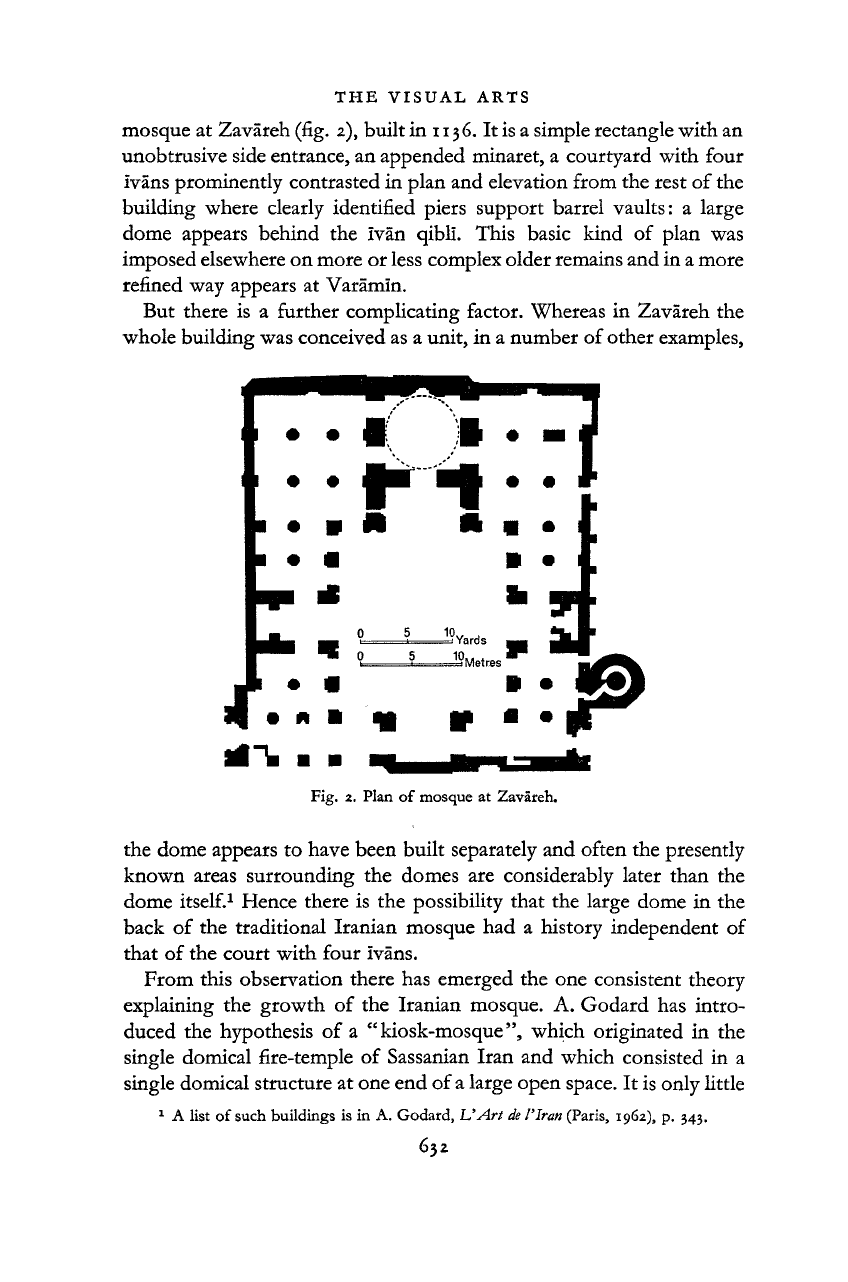
THE
VISUAL ARTS
Fig. 2.
Plan
of
mosque
at Zavareh.
the dome appears to have been built separately and often the presently
known
areas surrounding the domes are considerably later than the
dome itself.
1
Hence there is the possibility
that
the large dome in the
back
of the traditional Iranian mosque had a history independent of
that
of the court with four Ivans.
From this observation there has emerged the one consistent theory
explaining
the growth of the Iranian mosque. A. Godard has intro-
duced the hypothesis of a "kiosk-mosque", which originated in the
single
domical fire-temple of Sassanian Iran and which consisted in a
single
domical structure at one end of a large open space. It is only little
1
A
list
of
such
buildings
is in A. Godard,
UArt
de
VIran
(Paris,
1962),
p. 343.
mosque at Zavareh (fig. 2), built in
1136.
It is a simple rectangle with an
unobtrusive side entrance, an appended minaret, a courtyard with four
Ivans prominently contrasted in plan and elevation from the rest of the
building where clearly identified piers support barrel vaults: a large
dome appears behind the Ivan qibll. This basic kind of plan was
imposed elsewhere on more or less complex older remains and in a more
refined way appears at Varamin.
But
there is a further complicating factor. Whereas in Zavareh the
whole
building was conceived as a unit, in a number of other examples,
632
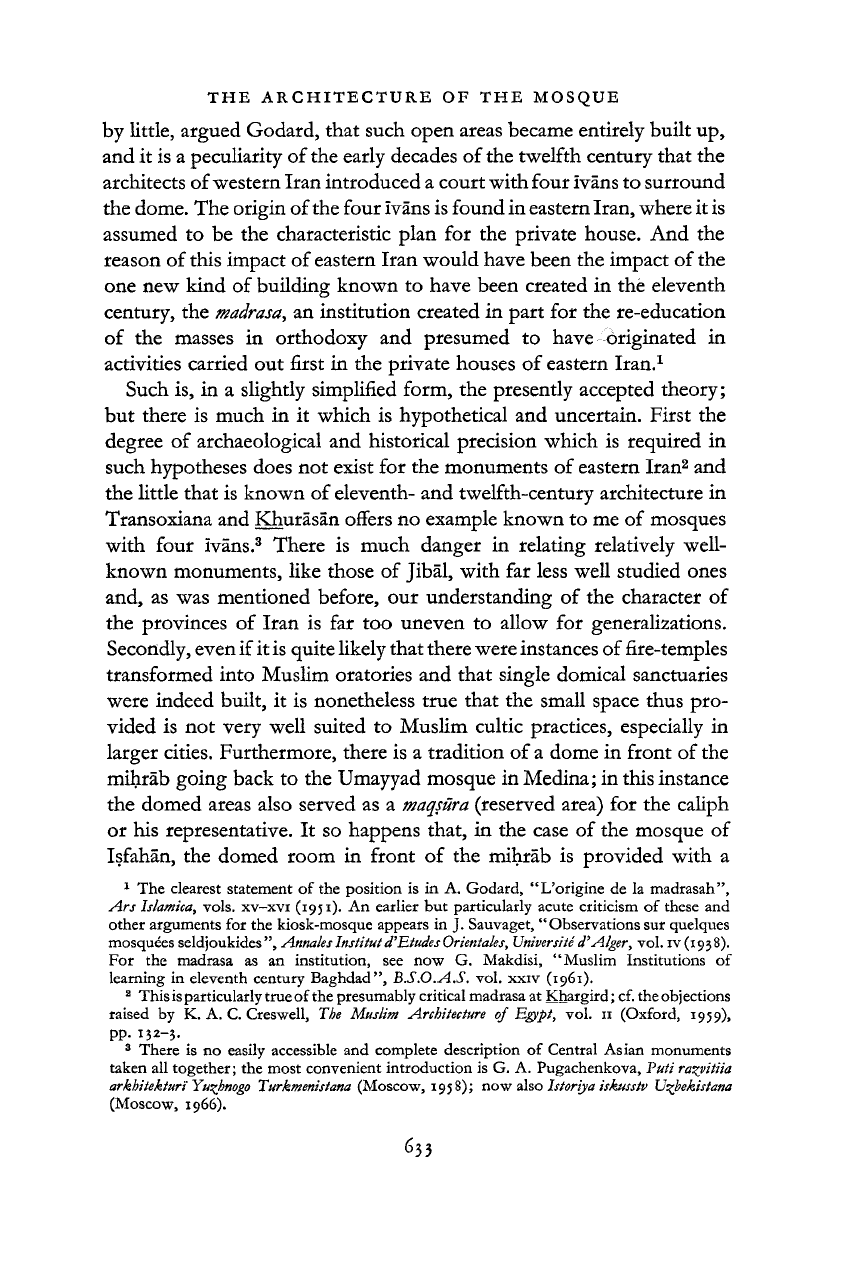
THE ARCHITECTURE OF THE MOSQUE
633
by
little, argued Godard,
that
such open areas became entirely built up,
and it is a peculiarity of the early decades of the twelfth century
that
the
architects
of
western
Iran
introduced a court with four ïvàns to surround
the dome. The origin
of
the four ïvàns is found in eastern
Iran,
where it is
assumed to be the characteristic plan for the private house. And the
reason of this impact of eastern
Iran
would have been the impact of the
one new kind of building known to have been created in the eleventh
century, the madrasa, an institution created in
part
for the re-education
of
the masses in orthodoxy and presumed to have -originated in
activities
carried out first in the private houses of eastern
Iran.
1
Such
is, in a slightly simplified form, the presently accepted theory;
but there is much in it which is hypothetical and uncertain. First the
degree of archaeological and historical precision which is required in
such hypotheses does not exist for the monuments of eastern
Iran
2
and
the little
that
is known of eleventh- and twelfth-century architecture in
Transoxiana and Khurasan offers no example known to me of mosques
with
four ïvàns.
3
There is much danger in relating relatively
well-
known
monuments, like those of Jibâl, with far less
well
studied ones
and, as was mentioned before, our understanding of the character of
the provinces of
Iran
is far too uneven to allow for generalizations.
Secondly,
even if it
is
quite
likely
that
there were instances of fire-temples
transformed into Muslim oratories and
that
single domical sanctuaries
were
indeed built, it is nonetheless
true
that
the small space
thus
pro-
vided
is not very
well
suited to Muslim cultic practices, especially in
larger cities. Furthermore, there is a tradition of a dome in front of the
mihràb going back to the Umayyad mosque in Medina; in this instance
the domed areas also served as
a maqsûra (reserved area) for the caliph
or his representative. It so happens
that,
in the case of the mosque of
Isfahan, the domed room in front of the mihràb is provided with a
1
The
clearest
statement
of the
position
is in A.
Godard,
"L'origine
de la
madrasah",
Ars
Islamica,
vols,
xv-xvi
(1951). An
earlier
but
particularly
acute
criticism
of
these
and
other
arguments
for the
kiosk-mosque
appears
in J.
Sauvaget,
"Observations
sur
quelques
mosquées
seldjoukides
Annales
Institut
d'Etudes
Orientales,
Université
d'Alger,
vol.
^(1938).
For the
madrasa
as an
institution,
see now G.
Makdisi,
"Muslim
Institutions
of
learning
in
eleventh
century
Baghdad",
B.S.O.A.S. vol.
xxiv
(1961).
2
This
is
particularly
true
of the
presumably
critical
madrasa
at
Khargird
;
cf. the
objections
raised
by K. A. C.
Creswell,
The
Muslim
Architecture
of
Egypt,
vol. 11
(Oxford,
1959),
pp.
132-3.
3
There
is no
easily accessible
and
complete description
of
Central
Asian
monuments
taken
all
together;
the
most
convenient
introduction
is G. A.
Pugachenkova,
Putt
ra^vitiia
arkhitekturt
Yu^hnogo
Turkmenistana
(Moscow,
1958);
now
also
htoriya
iskusstv
U^hekistana
(Moscow,
1966).
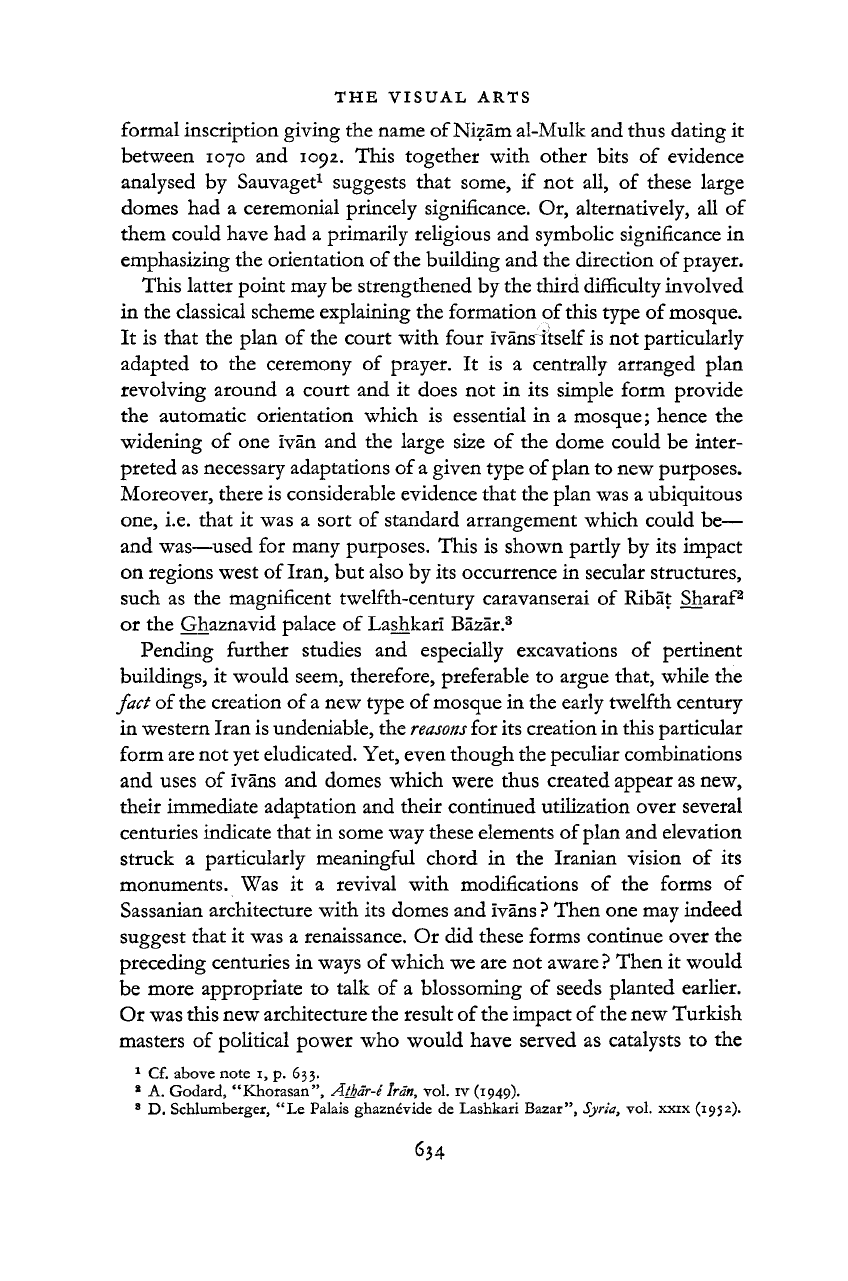
THE VISUAL ARTS
634
formal
inscription
giving
the name
of
Nizam
al-Mulk and
thus
dating it
between
1070 and 1092. This together with other bits of evidence
analysed
by Sauvaget
1
suggests
that
some, if not all, of these large
domes had a ceremonial princely significance. Or, alternatively, all of
them could have had a primarily religious and symbolic significance in
emphasizing
the orientation of the building and the direction of prayer.
This
latter point may be strengthened by the
third
difficulty
involved
in the classical scheme explaining the formation of this type of mosque.
It is
that
the plan of the court with four Ivansitself is not particularly
adapted to the ceremony of prayer. It is a centrally arranged plan
revolving
around a court and it does not in its simple form provide
the automatic orientation which is essential in a mosque; hence the
widening
of one Ivan and the large size of the dome could be
inter-
preted as necessary adaptations of a
given
type
of
plan to new purposes.
Moreover,
there
is considerable evidence
that
the plan was a ubiquitous
one,
i.e.
that
it was a sort of
standard
arrangement which could be—
and was—used for many purposes. This is shown partly by its impact
on regions west of
Iran,
but also by its occurrence in secular structures,
such as the magnificent twelfth-century caravanserai of Ribat Sharaf
2
or the Ghaznavid palace of Lashkarl Bazar.
3
Pending further studies and especially excavations of
pertinent
buildings,
it would seem, therefore, preferable to argue
that,
while the
fact of the creation of a new type of mosque in the early twelfth century
in western
Iran
is undeniable, the
reasons
for its creation in this particular
form
are not yet eludicated.
Yet,
even though the peculiar combinations
and uses of Ivans and domes which were
thus
created appear as new,
their immediate adaptation and their continued utilization over several
centuries indicate
that
in some way these elements
of
plan and elevation
struck a particularly meaningful chord in the
Iranian
vision of its
monuments. Was it a revival with modifications of the forms of
Sassanian architecture with its domes and Ivans
?
Then one may indeed
suggest
that
it was a renaissance. Or did these forms continue over the
preceding centuries in
ways
of which we are not aware
?
Then it would
be more appropriate to talk of a blossoming of seeds planted earlier.
Or
was this new architecture the result of the impact of the new Turkish
masters of political power who would have served as catalysts to the
1
Cf.
above
note
i, p. 633.
2
A.
Godard,
"Khorasan",
Athdr-S
Iran,
vol. rv
(1949).
8
D.
Schlumberger,
"Le
Palais
ghaznevide
de
Lashkari
Bazar",
Syria,
vol.
xxix (1952).
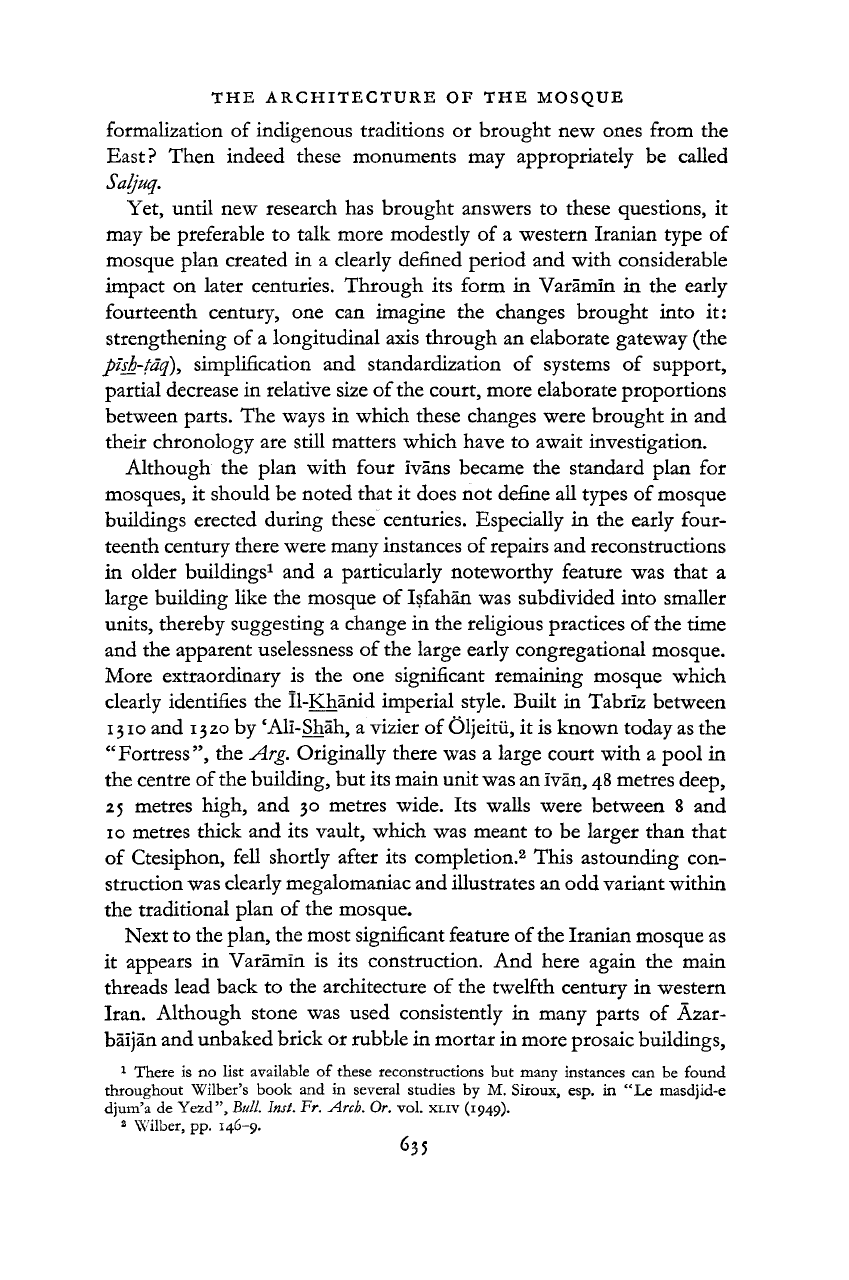
THE ARCHITECTURE OF THE MOSQUE
635
formalization of indigenous traditions or brought new ones from the
East? Then indeed these monuments may appropriately be called
Saljuq.
Yet,
until new research has brought answers to these questions, it
may be preferable to talk more modestly of a western
Iranian
type of
mosque plan created in a clearly defined period and with considerable
impact on later centuries. Through its form in Varamin in the early
fourteenth century, one can imagine the changes brought into it:
strengthening of a longitudinal axis through an elaborate gateway (the
pish-taq), simplification and standardization of systems of support,
partial decrease in relative size of the court, more elaborate proportions
between parts. The
ways
in which these changes were brought in and
their chronology are still
matters
which have to await investigation.
Although
the plan with four Ivans became the
standard
plan for
mosques, it should be noted
that
it does not define all types of mosque
buildings erected during these centuries. Especially in the early four-
teenth
century
there
were many instances
of
repairs and reconstructions
in older buildings
1
and a particularly noteworthy feature was
that
a
large building like the mosque of Isfahan was subdivided into smaller
units, thereby suggesting a change in the religious practices of the time
and the
apparent
uselessness of the large early congregational mosque.
More extraordinary is the one significant remaining mosque which
clearly
identifies the Il-Khanid imperial style. Built in Tabriz between
1310
and
13
20
by
'All-Shah,
a
vizier
of Oljeitu, it is known today as the
"Fortress", the Arg. Originally
there
was a large court with a pool in
the centre of the building, but its main
unit
was an Ivan, 48 metres deep,
25 metres high, and 30 metres wide. Its walls were between 8 and
10
metres thick and its vault, which was meant to be larger
than
that
of
Ctesiphon,
fell
shortly after its completion.
2
This astounding con-
struction was clearly megalomaniac and illustrates an odd variant within
the traditional plan of the mosque.
Next
to the plan, the most significant feature
of
the
Iranian
mosque as
it appears in Varamin is its construction. And here again the main
threads
lead back to the architecture of the twelfth century in western
Iran.
Although stone was used consistently in many
parts
of
Azar-
baijan and unbaked brick or rubble in
mortar
in more prosaic buildings,
1
There
is no
list
available
of
these
reconstructions
but
many
instances
can be
found
throughout
Wilber's
book
and in
several
studies
by M.
Siroux,
esp. in "Le
masdjid-e
djum'a
de
Yezd",
Bull.
Inst.
Fr.
Arch.
Or. vol.
XLIV
(1949).
2
Wilber,
pp.
146-9.
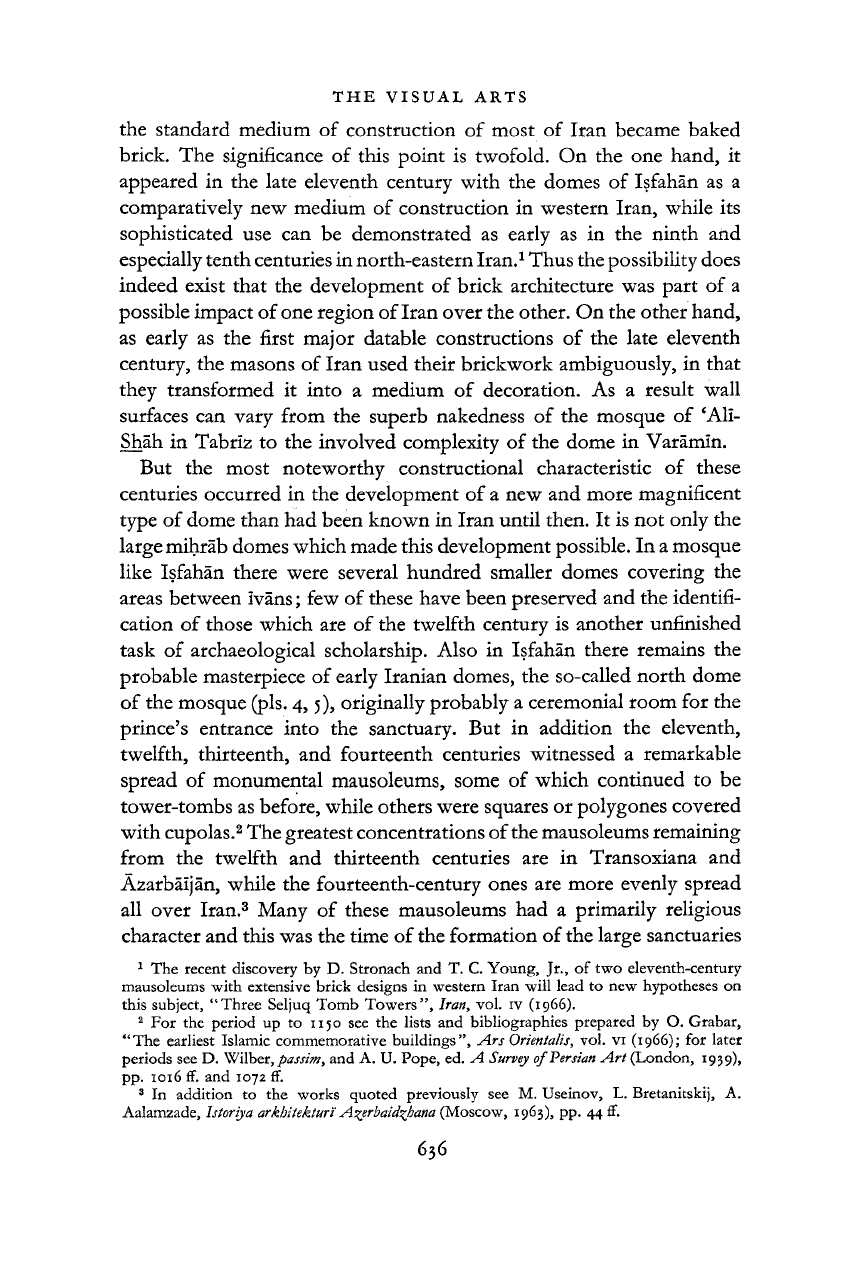
THE
VISUAL ARTS
636
the standard medium of construction of most of Iran became baked
brick.
The significance of this point is twofold. On the one hand, it
appeared in the late eleventh century with the domes of Isfahan as a
comparatively
new medium of construction in western Iran, while its
sophisticated use can be demonstrated as early as in the ninth and
especially
tenth centuries in north-eastern Iran.
1
Thus the possibility does
indeed exist
that
the development of brick architecture was part of a
possible
impact of one region
of
Iran over the other. On the other hand,
as early as the first major datable constructions of the late eleventh
century, the masons of Iran used their brickwork ambiguously, in
that
they transformed it into a medium of decoration. As a result
wall
surfaces
can vary from the superb nakedness of the mosque of 'All-
Shah in Tabriz to the involved complexity of the dome in Varamln.
But
the most noteworthy constructional characteristic of these
centuries occurred in the development of a new and more magnificent
type of dome than had been known in Iran until then. It is not only the
large
mihrab domes which made this development possible. In a mosque
like
Isfahan there were several hundred smaller domes covering the
areas between Ivans; few of these have been preserved and the identifi-
cation of those which are of the twelfth century is another unfinished
task of archaeological scholarship.
Also
in Isfahan there remains the
probable masterpiece of early Iranian domes, the so-called north dome
of
the mosque (pis. 4,5), originally probably a ceremonial room for the
prince's entrance into the sanctuary. But in addition the eleventh,
twelfth,
thirteenth, and fourteenth centuries witnessed a remarkable
spread of monumental mausoleums, some of which continued to be
tower-tombs as before, while others were squares or polygones covered
with
cupolas.
2
The greatest concentrations
of
the mausoleums remaining
from
the twelfth and thirteenth centuries are in Transoxiana and
Azarbaljan,
while the fourteenth-century ones are more evenly spread
all
over Iran.
3
Many of these mausoleums had a primarily religious
character and this was the time of the formation of the large sanctuaries
1
The
recent
discovery
by D.
Stronach
and T. C. Young, Jr., of two
eleventh-century
mausoleums
with
extensive
brick
designs
in
western
Iran
will
lead
to new
hypotheses
on
this
subject,
"Three
Seljuq
Tomb
Towers",
Iran,
vol. iv
(1966).
2
For the
period
up to 1150 see the
lists
and
bibliographies
prepared
by O. Grabar,
"The
earliest
Islamic
commemorative
buildings",
Ars
Orientalis,
vol. vi
(1966);
for
later
periods
see D. Wilber,
passim,
and A. U.
Pope,
ed. A
Survey
of
Persian
Art
(London,
1939),
pp. 1016
ft*,
and 1072 ff.
3
In
addition
to the
works
quoted
previously
see M.
Useinov,
L. Bretanitskij, A.
Aalamzade,
Istoriya
arkhitekturi
A^erbaid^hana
(Moscow,
1963),
pp. 44 ff.
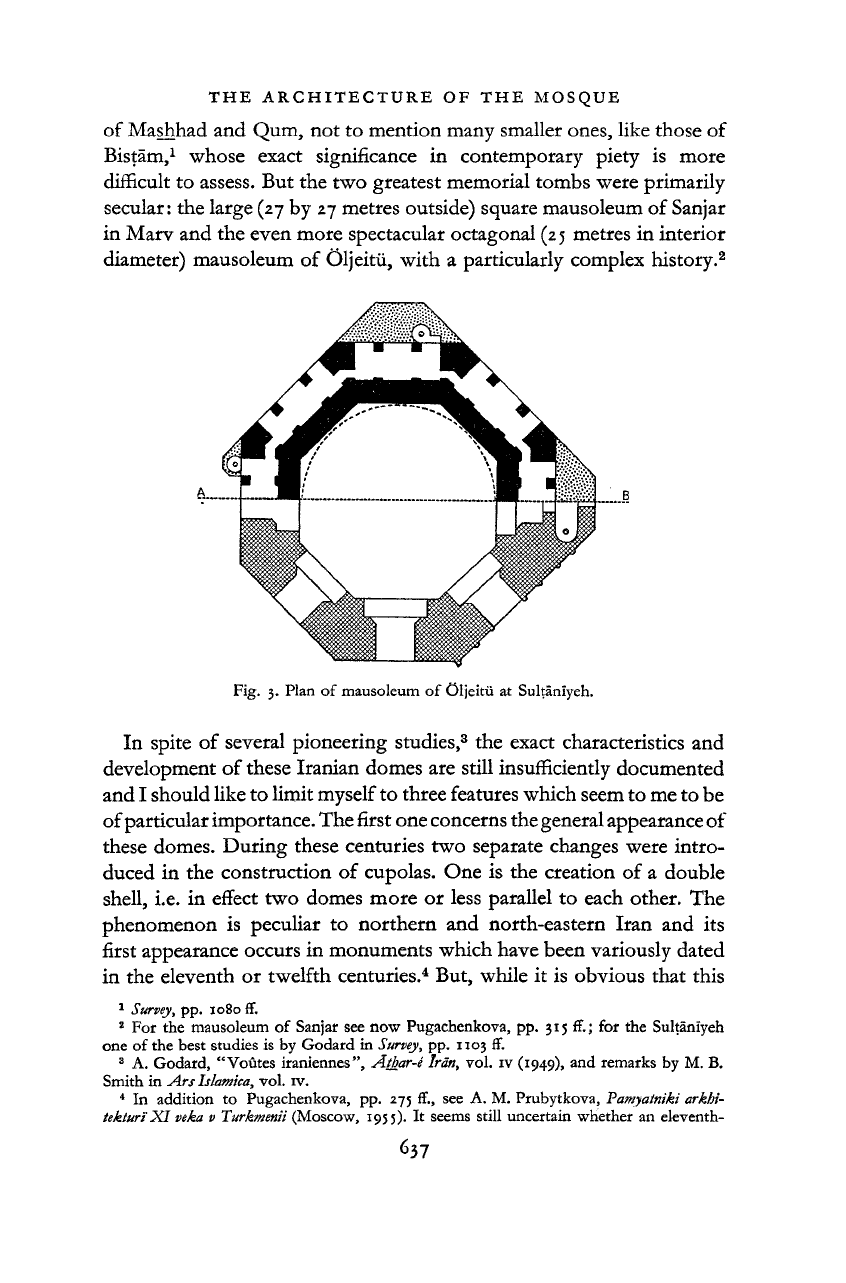
THE
ARCHITECTURE OF THE MOSQUE
\
1
В
Fig. 3.
Plan
of
mausoleum
of
Oljeitu
at
Sultaniyeh.
In spite of several pioneering studies,
3
the exact characteristics and
development of these Iranian domes are still insufficiently documented
and I should like to limit
myself
to
three
features which seem to me to be
of
particular importance. The first one concerns the general appearance
of
these domes. During these centuries two separate changes were intro-
duced in the construction of cupolas. One is the creation of a double
shell,
i.e. in
effect
two domes more or less parallel to each other. The
phenomenon is peculiar to
northern
and north-eastern
Iran
and its
first appearance occurs in monuments which have been variously dated
in the eleventh or twelfth centuries.
4
But, while it is obvious
that
this
1
Survey,
pp. 1080 fT.
2
For the
mausoleum
of
Sanjar
see now
Pugachenkova,
pp. 315 fT.; for the
Sultaniyeh
one of the
best
studies
is by Godard in
Survey,
pp. 1103 fT.
8
A. Godard,
"Voutes
iraniennes",
Athar-e Iran,
vol. iv
(1949),
and
remarks
by M. B.
Smith
in Ars
hlamica,
vol. iv.
4
In
addition
to
Pugachenkova,
pp. 275 ff., see A. M. Prubytkova,
Pamyatniki
arkhi-
tekturi'XI
veka
v
Turkmenti
(Moscow,
1955). It
seems
still
uncertain
whether
an
eleventh-
of
Mashhad and Qum, not to mention many smaller ones, like those of
Bistam,
1
whose exact significance in contemporary piety is more
difficult
to assess. But the two greatest memorial tombs were primarily
secular: the large (27 by 27 metres outside) square mausoleum of Sanjar
in Marv and the even more spectacular octagonal (25 metres in interior
diameter) mausoleum of Oljeitu, with a particularly complex history.
2
637
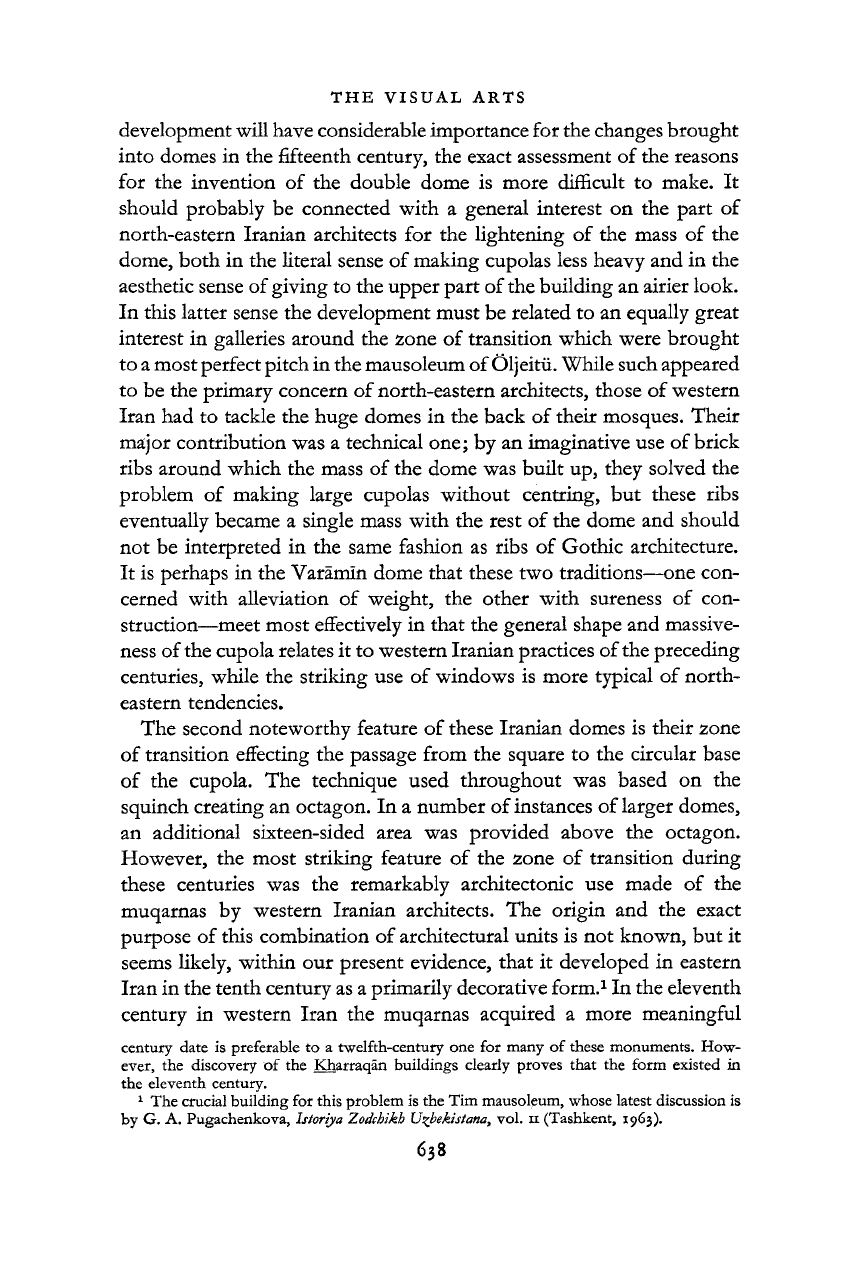
THE
VISUAL ARTS
638
development
will
have considerable importance for the changes brought
into domes in the fifteenth century, the exact assessment of the reasons
for
the invention of the double dome is more difficult to make. It
should probably be connected with a general interest on the
part
of
north-eastern Iranian architects for the lightening of the mass of the
dome, both in the literal sense of making cupolas less heavy and in the
aesthetic sense of
giving
to the upper
part
of the building an airier look.
In this latter sense the development must be related to an equally great
interest in galleries around the zone of transition which were brought
to a most perfect pitch in the mausoleum
of
Oljeitu.
While such appeared
to be the primary concern of north-eastern architects, those of western
Iran
had to tackle the huge domes in the back of their mosques. Their
major contribution was a technical one; by an imaginative use of brick
ribs around which the mass of the dome was built up, they solved the
problem of making large cupolas without centring, but these ribs
eventually
became a single mass with the rest of the dome and should
not be interpreted in the same fashion as ribs of Gothic architecture.
It is perhaps in the Varamin dome
that
these two traditions—one con-
cerned with alleviation of weight, the other with sureness of con-
struction—meet most
effectively
in
that
the general shape and massive-
ness
of
the cupola relates it to western Iranian practices
of
the preceding
centuries, while the striking use of windows is more typical of
north-
eastern tendencies.
The
second noteworthy feature of these Iranian domes is their zone
of
transition effecting the passage from the square to the circular base
of
the cupola. The technique used throughout was based on the
squinch creating an octagon. In a number of instances of larger domes,
an additional sixteen-sided area was provided above the octagon.
However,
the most striking feature of the zone of transition during
these centuries was the remarkably architectonic use made of the
muqarnas by western Iranian architects. The origin and the exact
purpose of this combination of architectural units is not known, but it
seems
likely,
within our present evidence,
that
it developed in eastern
Iran
in the
tenth
century as a primarily decorative form.
1
In the eleventh
century in western
Iran
the muqarnas acquired a more meaningful
century
date
is
preferable
to a
twelfth-century
one for
many
of
these
monuments.
How-
ever,
the
discovery
of the Kharraqan
buildings
clearly
proves
that
the
form
existed
in
the
eleventh
century.
1
The
crucial
building
for
this
problem
is the Tim
mausoleum,
whose
latest
discussion
is
by G. A.
Pugachenkova,
htoriya
Zodchikh
U^bekistana,
vol. n
(Tashkent, 1963).
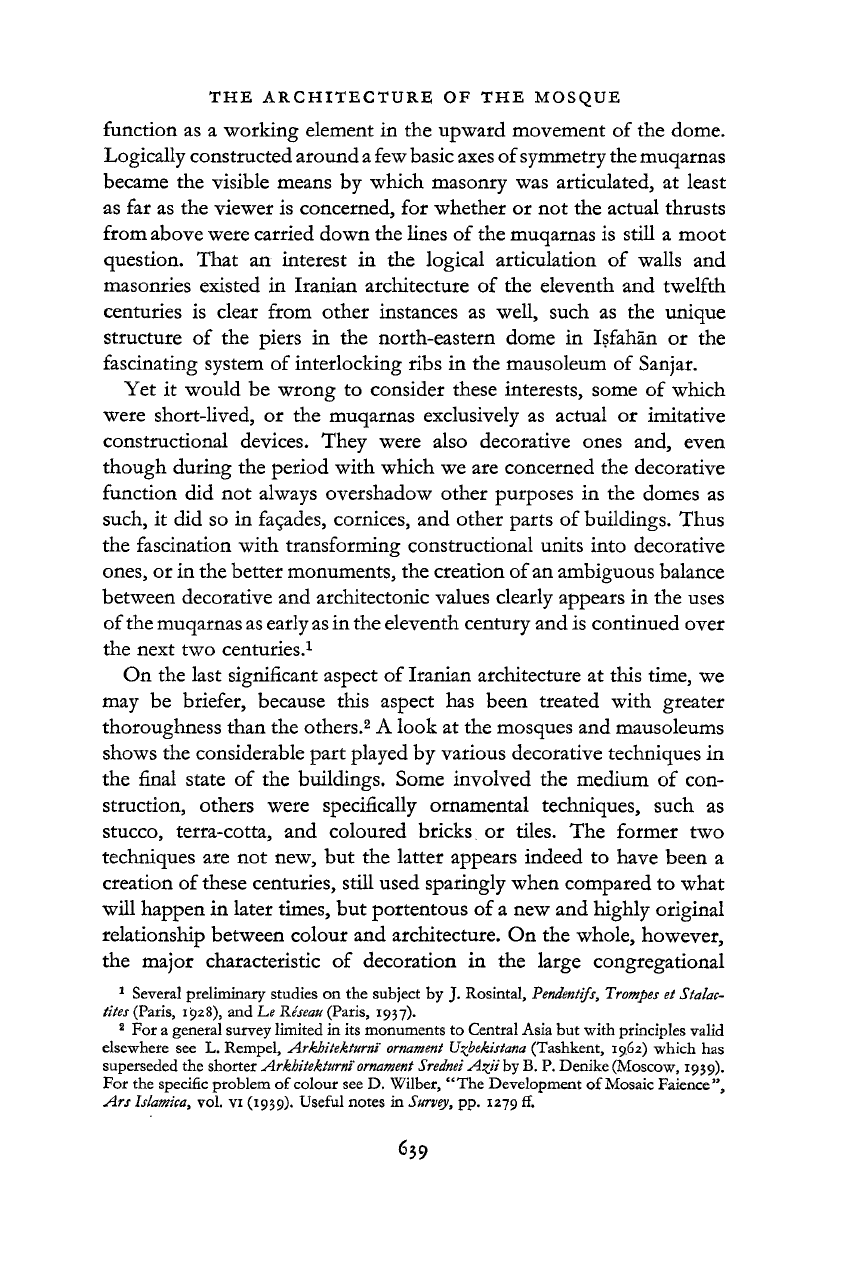
THE
ARCHITECTURE OF THE MOSQUE
6?9
function as a working element in the upward movement of the dome.
Logically
constructed around a few basic axes
of
symmetry the muqarnas
became the visible means by which masonry was articulated, at least
as far as the viewer is concerned, for whether or not the actual
thrusts
from
above were carried down the lines of the muqarnas is still a moot
question. That an interest in the logical articulation of walls and
masonries existed in Iranian architecture of the eleventh and twelfth
centuries is clear from other instances as
well,
such as the unique
structure of the piers in the north-eastern dome in Isfahan or the
fascinating
system of interlocking ribs in the mausoleum of Sanjar.
Yet
it would be wrong to consider these interests, some of which
were
short-lived, or the muqarnas exclusively as actual or imitative
constructional devices. They were also decorative ones and, even
though during the period with which we are concerned the decorative
function did not always overshadow other purposes in the domes as
such,
it did so in façades, cornices, and other
parts
of buildings. Thus
the fascination with transforming constructional units into decorative
ones,
or in the better monuments, the creation
of
an ambiguous balance
between
decorative and architectonic values clearly appears in the uses
of
the muqarnas as early
as
in the eleventh century and is continued over
the next two centuries.
1
On
the last significant aspect of Iranian architecture at this time, we
may
be briefer, because this aspect has been treated with greater
thoroughness
than
the others.
2
A look at the mosques and mausoleums
shows
the considerable
part
played by various decorative techniques in
the final
state
of the buildings. Some involved the medium of con-
struction, others were specifically ornamental techniques, such as
stucco,
terra-cotta, and coloured bricks or tiles. The former two
techniques are not new, but the latter appears indeed to have been a
creation of these centuries, still used sparingly when compared to what
will
happen in later times, but portentous of a new and highly original
relationship between colour and architecture. On the whole, however,
the major characteristic of decoration in the large congregational
1
Several
preliminary
studies
on the
subject
by J.
Rosintal,
Pendentifs,
Trompes
et
Stalac-
tites
(Paris, 1928),
and Le
Réseau
(Paris,
1937).
2
For a
general
survey
limited
in its
monuments
to Central
Asia
but
with
principles
valid
elsewhere
see L.
Rempel,
Arkhitekturnï
ornament
U^bekistana
(Tashkent,
19.62)
which
has
superseded
the
shorter
Arkhitekturnï
ornament
Srednei
A%iihyB.
P.
Denike
(Moscow,
1939).
For the
specific
problem
of
colour
see D.
Wilber,
"The
Development
of
Mosaic
Faience",
Ars
Islamica,
vol. vi
(1939).
Useful
notes
in
Survey,
pp. 1279 ff.
